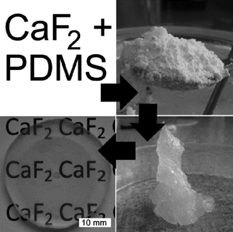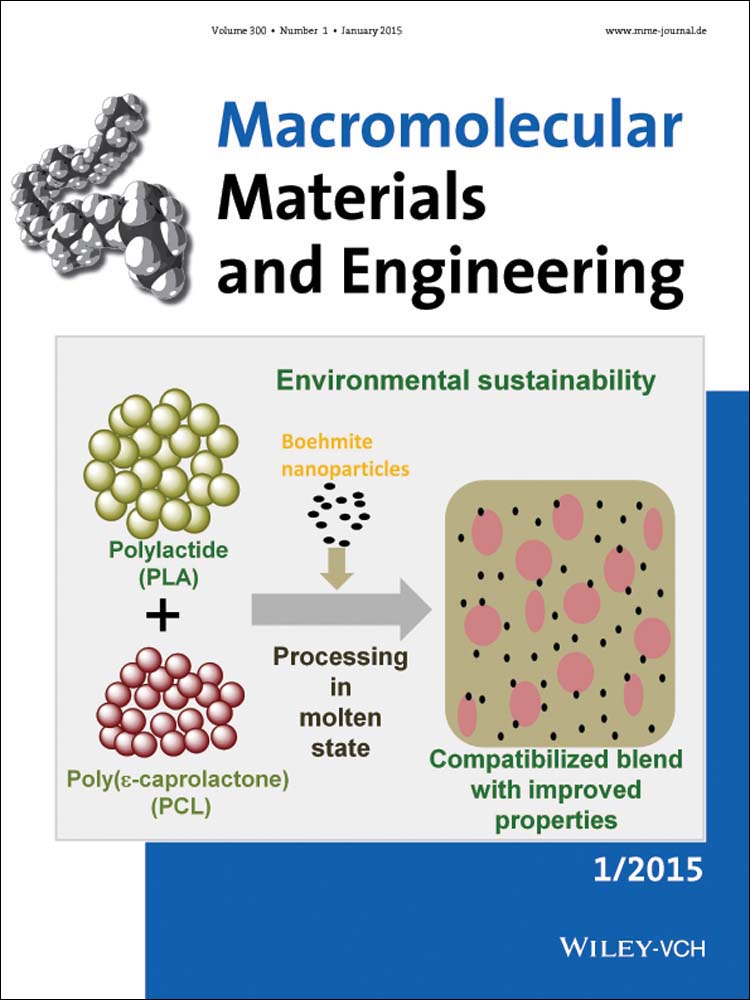Transparent Silicone Calcium Fluoride Nanocomposite with Improved Thermal Conductivity
Corresponding Author
René Schneider
Empa, Swiss Federal Laboratories for Material Science and Technology, Überlandstrasse 129, 8600 Dübendorf, Switzerland
Search for more papers by this authorStefan R. Lüthi
Interstate University of Applied Sciences of Technology Buchs, Institute for Micro- and Nanotechnology, Werdenbergstrasse 4, 9471 Buchs, Switzerland
Search for more papers by this authorKatrin Albrecht
Interstate University of Applied Sciences of Technology Buchs, Institute for Micro- and Nanotechnology, Werdenbergstrasse 4, 9471 Buchs, Switzerland
Search for more papers by this authorMartina Brülisauer
Interstate University of Applied Sciences of Technology Buchs, Institute for Micro- and Nanotechnology, Werdenbergstrasse 4, 9471 Buchs, Switzerland
Search for more papers by this authorAndré Bernard
Interstate University of Applied Sciences of Technology Buchs, Institute for Micro- and Nanotechnology, Werdenbergstrasse 4, 9471 Buchs, Switzerland
Search for more papers by this authorThomas Geiger
Empa, Swiss Federal Laboratories for Material Science and Technology, Überlandstrasse 129, 8600 Dübendorf, Switzerland
Search for more papers by this authorCorresponding Author
René Schneider
Empa, Swiss Federal Laboratories for Material Science and Technology, Überlandstrasse 129, 8600 Dübendorf, Switzerland
Search for more papers by this authorStefan R. Lüthi
Interstate University of Applied Sciences of Technology Buchs, Institute for Micro- and Nanotechnology, Werdenbergstrasse 4, 9471 Buchs, Switzerland
Search for more papers by this authorKatrin Albrecht
Interstate University of Applied Sciences of Technology Buchs, Institute for Micro- and Nanotechnology, Werdenbergstrasse 4, 9471 Buchs, Switzerland
Search for more papers by this authorMartina Brülisauer
Interstate University of Applied Sciences of Technology Buchs, Institute for Micro- and Nanotechnology, Werdenbergstrasse 4, 9471 Buchs, Switzerland
Search for more papers by this authorAndré Bernard
Interstate University of Applied Sciences of Technology Buchs, Institute for Micro- and Nanotechnology, Werdenbergstrasse 4, 9471 Buchs, Switzerland
Search for more papers by this authorThomas Geiger
Empa, Swiss Federal Laboratories for Material Science and Technology, Überlandstrasse 129, 8600 Dübendorf, Switzerland
Search for more papers by this authorAbstract
Heat dissipation is an important issue in many electronic devices and therefore materials showing high thermal conductivity are required for their construction and packaging. The intrinsically low thermal conductivity of polymeric materials can be improved when employing (nano-) composites; however, the required high filler content then renders these materials opaque. This paper reports on a composite material that combines high transparency and improved thermal conductivity by using calcium fluoride (CaF2) particles in a silicone elastomer. The refractive index of the silicone matrix is matched to the filler material, light scattering is prevented, and transparent composites with enhanced thermal conductivity at modest filler content (starting at 0.2 volume fraction) are obtained.
References
- 1 N. Narendran, Y. Gu, J. Disp. Technol. 2005, 1, 167.
- 2 R. Kochetov, A. V. Korobko, T. Andritsch, P. H. F. Morshuis, S. J. Picken, J. J. Smit, J. Phys. D. Appl. Phys. 2011, 44, 395401.
- 3 H. Ishida, S. Rimdusit, Thermochim. Acta 1998, 320, 177.
- 4 M. Iqbal, M. McCullough, A. Harris, S. H. Eichhorn, J. Therm. Anal. Calorim. 2012, 108, 933.
- 5 K. L. Chan, M. Mariatti, Z. Lockman, L. C. Sim, J. Appl. Polym. Sci. 2011, 121, 3145.
- 6 I. A. Ventura, A. Rahaman, G. Lubineau, J. Appl. Polym. Sci. 2013, 130, 2722.
- 7 S. Agarwal, R. K. Gupta, in: “ Polymer Nanocomposites Handbook”, R. K. Gupta, E. Kennel, K-. J. Kim, Eds., Taylor and Francis Group, Boka Raton, USA 2010.
- 8 C. Y. Zhi, Y. Bando, C. C. Tang, Q. Huang, D. Golberg, J. Mater. Chem. 2008, 18, 3900.
- 9 S. Morimune, M. Kotera, T. Nishino, K. Goto, K. Hata, Macromolecules 2011, 44, 4415.
- 10 N. Balachander, I. Seshadri, R. J. Mehta, L. S. Schadler, T. Borca-Tasciuc, P. Keblinski, G. Ramanath, Appl. Phys. Lett. 2013, 102, 093117.
- 11 Y. Shimazaki, Y. Miyazaki, Y. Takezawa, M. Nogi, K. Abe, S. Ifuku, H. Yano, H. Chemical, Biomacromolecules 2007, 8, 2976.
- 12 Y. Sun, A. Gu, G. Liang, L. Yuan, J. Appl. Polym. Sci. 2011, 121, 2018.
- 13 H. Althues, J. Henle, S. Kaskel, Chem. Soc. Rev. 2007, 36, 1454.
- 14 M. M. Demir, G. Wegner, Macromol. Mater. Eng. 2012, 297, 838.
- 15 P. N. Pusey, W. van Megen, Nature 1986, 320, 340.
- 16 M. Wiemann, R. Schneider, E. Bartsch, Zeitschrift für Phys. Chem. 2012, 226, 761.
- 17 D. B. A. Nandiyanto, T. Ogi, A. Ohmura, E. Tanabe, Kona Powder Part. J. 2011, 29, 141.
- 18 M. Markovic, S. Takagi, S. Frukhtbeyn, J. Res. Natl. Inst. Stand. Technol. 2009, 114, 293.
- 19 R. C. Progelhof, J. L. Throne, R. R. Ruetsch, Polym. Eng. Sci. 1976, 16, 615.
- 20 X.-J. Wang, L.-Z. Zhang, L.-X. Pei, J. Appl. Polym. Sci. 2013, 131, 39550.
- 21 I. H. Malitson, Appl. Opt. 1963, 2, 1103.
- 22 G. M. Whitesides, S. K. Y. Tang, Proc. SPIE 2006, 6329, 63290A.
- 23
U. Wallrabe,
J. Draheim,
Phys. Zeit
2012,
43, 84.
10.1002/piuz.201101287 Google Scholar
- 24 T. Geruschke, PhD Thesis, Rheinischen Friedrich–Wilhelms–Universität Bonn 2010.
- 25 M. D. Weir, J. L. Moreau, E. D. Levine, H. E. Strassler, L. C. Chow, H. H. K. Xu, Dent. Mater. 2012, 28, 642.
- 26 O. Nakhaei, N. Shahtahmassebi, M. Rezaeeroknabadi, M. M. Bagheri Mohagheghi, Sci. Iran. 2012, 19, 1979.
- 27 H. Khalil, H.-J. Gläsel, K. Köhler, F. Hardinghaus, M. R. Buchmeiser, Macromol. Mater. Eng. 2010, 295, 276.
- 28 Ga. Kumar, C. W. Chen, R. Riman, S. Chen, D. Smith, J. Ballato, Appl. Phys. Lett. 2005, 86, 241105.
- 29 J. A. Lewis, Colloidal Process. Ceram. 2000, 59, 2341.
- 30 K. A. Becraft, F. G. Moore, G. L. Richmond, J. Phys. Chem. B 2003, 107, 3675.
- 31 V. Y. Rudyak, Adv. Nanoparticles 2013, 2, 266.
- 32 Q. Mu, S. Feng, G. Diao, Polym. Compos. 2007, 28, 125.
- 33 O. Shenderova, T. Tyler, G. Cunningham, M. Ray, J. Walsh, M. Casulli, S. Hens, G. McGuire, V. Kuznetsov, S. Lipa, Diam. Relat. Mater. 2007, 16, 1213.
- 34 J.-W. Zha, Y.-H. Zhu, W.-K. Li, J. Bai, Z.-M. Dang, Appl. Phys. Lett. 2012, 101, 062905.
- 35 W. Y. Zhou, J. T. Cai, A. N. Zhou, Adv. Mater. Res. 2011, 194–196, 1680.




